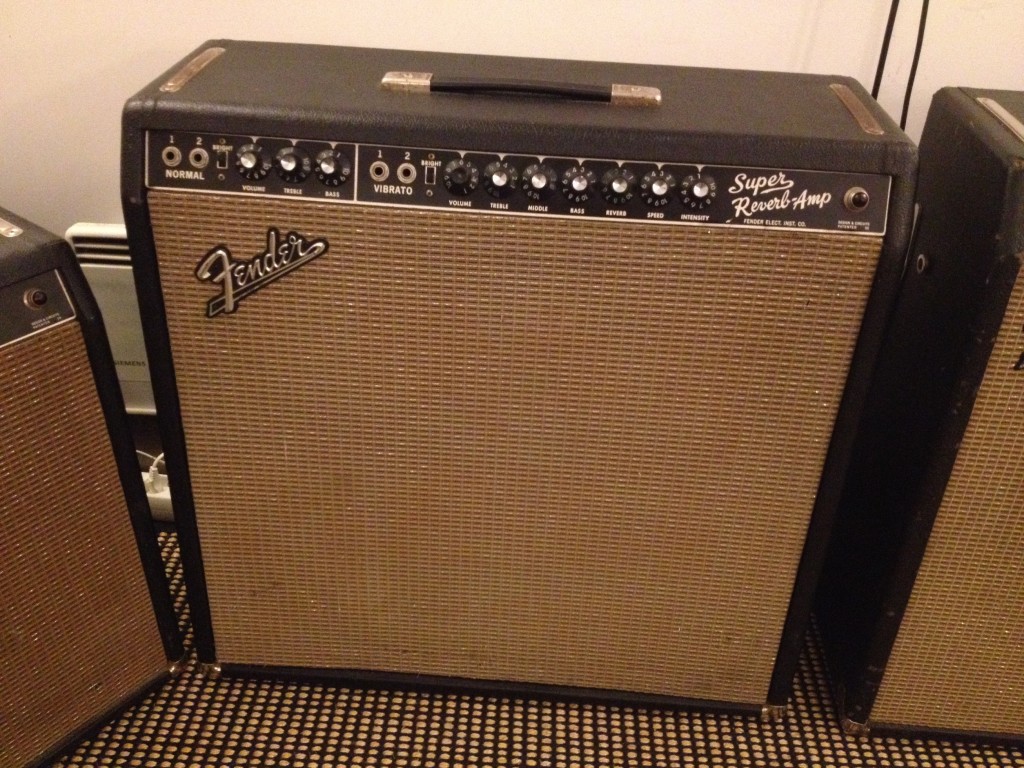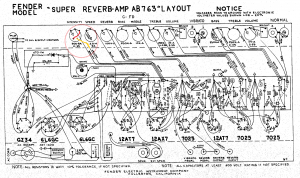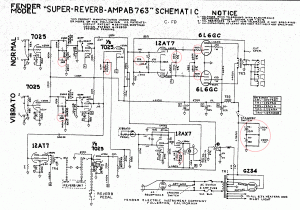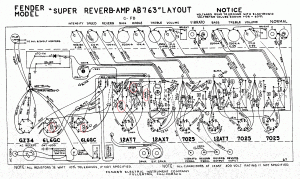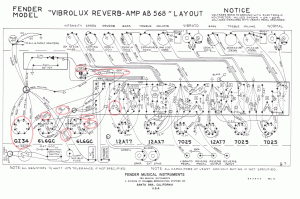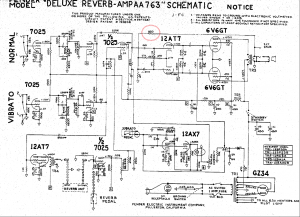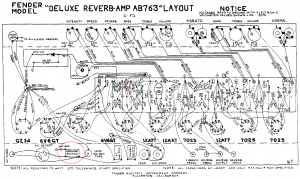Production years:
- 1964 -1967 blackface circuits AA763, AB763
- 1967 -1969 silverface circuits AB763, AB568
- 1969 -1978 silverface circuits AA1069, AA270, cbs 45w MstrVol, cbs 70w MstrVol
Tube layout
AA763/AB763 Tube layout (Seen from behind, V1 is to the right side)
- V1 12ax7 = Preamp normal channel
- V2 12ax7 = Preamp vibrato channel
- V3 12at7 = Reverb send
- V4 12ax7 = 1/2 Reverb recovery and 1/2 gain stage for vibrato channel
- V5 12ax7 = Vibrato
- V6 12at7 = Phase inverter
- V7 6L6 = Power tube #1
- V8 6L6 = Power tube #2
- V9 GZ34 = Rectifier tube
Summary
The AB763 Super Reverb is a very popular Fender amp due to the huge tone, robustness and the pure tone from the traditional blackface AB763 amp design. The AB763 design is also to be found in some silverface amps between 1967 and 1969. The later silverface circuits were changed further by CBS to become cleaner, harder and thinner sounding, specially if one compares amps at the same volume and EQ setting. If you’re into sparkling clean tones, a silverface can do the job just as well as a blackface amp. The blackfaces have more growl and a distorted, cranked tone. It is heavy to carry with the 4×10″ speakers and massive iron transformers. The height also makes it difficult to carry, making you sweat when hauling it between gigs. It’s a big sounding amp with a potential for being very loud and bassy given the right (wrong) speakers. The nature of the 4×10″ speaker configuration is a directional tone with screaming treble right forwards and backwards and unfortunately little spread. A lot of deep bass is produced by the bigt cabinet while the important mids are fairly low, a scooped tone. Many players are stupid and increase the volume to compensate for the lack of spread and mids. This will introduce even more bass and sharp treble. Playing the Super Reverb is not supposed to be easy… Despite all the difficultness with this amp there will occasionally be gigs, perhaps outdoors or at a big stage, where the amp won’t hurt anyone in a radius of 3 meters. You are allowed to turn the volume beoynd 4 where the amp comes alive. We remember these occasions as our happiest musical moments. The notes bounce off our strings and we are musically and physically connected with the amp just using the pick attack and guitar volume to roll back and switch between rythm and solo. Perhaps a transparent boost pedal to take us into David Gilmour land with sustain, harmonics and a creamy tone. You can physically feel the dynamic response from one of the best vintage Fender amps of them all. But only if you know how to tame this beast.
Many players have spent years chasing speakers, guitars and pickups to avoid the typical trebly and sharp tone of some Fender amps. It requires some experience to get a balanced and sweet tone from a Super Reverb because of its power and loud speaker configuration. Most of the maintenance and mod tips below are recommended for those who want the amp to break up earlier, reaching the sweet spot at a lower volume. Tube mods, such as pulling the V1 out and using a 12ax7 as V6/PI, will take you a long way. Next, if your speakers are efficient and too loud for the occasion, then why not disconnect two of them in just 5 seconds? If you also invested in implementing the tremolo disconnect mod, you may turn an ear-bleeding Super Reverb into a tone machine with a fatter, warmer and fuller tone at practise volumes. While all these mods will not make a big difference on their own, together they will tame a Super Reverb to the Vibrolux/Deluxe Reverb area.
You’ll need schematics to implement some of these mods. http://www.ampwares.com/fender.asp. We usually start with explaining a mod from a functional perspective where we relate to components in the logical schematics diagram. Finally we point out location of components in the physical layout diagram.
Five fundamental tricks to create the holy grail of Fender tone
Here is a video demonstrating the effects of some of the mods and tricks described here. To see embedded text comments, go to video on Youtube.
Speakers
Fender sold these amps with several speakers. The first AA763 models in 1964-65 had Jensen C10r. Then there were CTS ceramics and alnicos as well as Oxford 10L6 in the blackface AB763 amps. In the silverface amps Fender continued with Oxford and CTS but also used Utah, Rola and Eminence. This is one important reason why two Super Reverbs can sound very different. In our opinion the Super Reverbs with Jensen and CTS are valuable as both collectors and players’ amps today. These speakers perform very well and one does not need to upgrade to modern, efficient speakers like for many other vintage speakers. The CTS alnicos are also very popular speakers even if they are little efficient. During the years the Alnico magnets get weaker too. The CTS Alnico require you to increase the volume a lot and you’ll see players that dial in their amps at 6 or 7 on the volume knob. With ceramic speakers this is enormously loud. With vintage Alnico speakers you will get more breakup from the amp due to their low efficiency. On the other hand, the CTS ceramics are known for their power, efficiency and full low end. They also have lots of sparkle and treble and are very good speakers in our opinion. An amp with the original speakers will be more valuable than one with any non-original speakers, even of the originals are blown Speaker reconing has become a growing business the latest years, allowing players to play their vintage amps and still preserve their originality. Reconed speakers may not even sound like the originals, sometimes they even sound better.
Below is a precious 64 blackface Super Reverb with Jensen C10r speakers.
Swapping the speakers is the most effective change you possibly can do to change the tone of your amp. In a 4×10″ application why would you want highly efficient and powerful speakers? The volume and weight of such speakers is often a burden, not to mention the loss of dynamics and touch sensitivity that normally comes with powerful speakers. We’ve seen many players in their early years seeking maximum volume and punch in their amps. When they’ve played loud and rough for some years, they get tired and realize that high volume didn’t make them better players. Some discovered that it even made them worse. After chasing volume, many will start hunting the correct vintage tone and it’s all about getting the “vintage correct” speakers, new or old. The good thing with vintage speakers is their light weight. As the years go by you’ll be more and more concerned with the amp’s weight. You realize that you are able to create beautiful music without big, powerful speakers. Most important, the audience will be more happy once you concentrate on the music and dynamics rather than volume.
Such morale stories should lead us to the fact that amp weight is important. Installing four powerful 50W+ speakers with heavy magnets will sooner or later force you and your back to park the amp in your basement. Volume won’t take you anywhere. In stead you should make use of the flexibility that comes with a 4×10″ configuration. With lighter, less powerful and perhaps less efficient speakers, you’ll be able utilize more breakup from the amp. If you are gigging with your Super Reverb in different environments we find it useful to install a mix of speakers that bring different qualities to the table. By enabling and rewiring the speakers you can quickly switch your tone depending on what the specific gig requires. Good configurations can be
- Jensen P10r + C10q
- Jensen P10q + Jensen Jet Tornado
- Eminence Copperhead + Legend 1028K
- Eminence Copperhead + Ragin Cajun
- Eminence Legend 1058 + Weber 10F150/10F125
- Weber 10A125 + 10F125/10F150
- Weber 10A125/10F125 + 10A150
- Warehouse Veteran 10″ + G10c (or Weber 10A125/10F125/10A150)
See page How to select speakers for general speaker recommendations.
The Super Reverb can be really loud and even interfer with the bass guitar. A simple trick is to pull out two of the speakers for less volume and earlier breakup. Not only do you reduce the speaker areal and bass tones, the tubes are pushed harder when seeing a 4 ohm load in stead of 2. You’ll achieve sweet spot at a lower volume.
Check this video to hear the Weber 10A150 in a Fender Super Reverb (video on Youtube). Just two speakers, 2 ohm OT, tremolo disconnect mod and V1 tube pulled out.
This video shows several 10″ speakers; Warehouse Veteran, Eminence Legend Alnico “blue frame”, Jensen NEO-100, Weber 10A125/10F125 (video on Youtube). Just two speakers are enabled (4 ohms) with a 65 Super Reverb having tremolo disconnect mod and V1 tube pulled out.
12AY7 or 12AT7 as preamp tubes – Less preamp gain.
If you want cleaner and spankier preamp distortion charcteristics, you may replace the V1 or V2 12AX7 preamp tube with 12AT7 and 12AY7. These tubes have different frequency responses than 12AX7, particurlarly when distorting. People describe these tubes to have less harsh and buzzy distortion. This mod does not alter the tone significantly when amp is played clean or when only the power amp section distorts. You’ll have to increase the volume setting to achieve a similar volume as before. The reason is that 12AX7 tube has a voltage gain factor = 100, while 12AT7 = 60 and 12AY7 = 45.
Pull out the V1 normal channel preamp tube – More preamp gain in vibrato channel
We’ll start with saying that this is a mod we personally do to all dual channel blackface, silverface and reissue amps. It is so easy to enable and disable that it can hardly be called a mod. If you are like most players and only use the Vibrato channel (reverb, tremolo, the bright cap and the extra gain stage), you should pull out the V1 tube. This is the preamp tube for the normal channel which you are not using when playing the Vibrato channel. Vice versa; If you’re using the Normal channel, you can pull out the V2 tube. All AB763-similar circuits (Deluxe Reverb, Super Reverb, Pro Reverb, Twin Reverb, Vibroverb, Vibrolux) are designed so that they share the cathode cap and resistor (25 uF/1500 ohm) and pulling one of the tubes will changes the effective value of the resistor they both share. If you pull one tube the other channel’s tube will be hotter biased and offers more gain. The amp will play louder than before given the same volume knob setting. The stronger signal will push the second gain stage (V4 tube) harder and give you increased sustain, compression and harmomics. This mod does not change the amp’s clean headroom but increases the preamp gain and preamp distortion.
This mod is one of Cesar Diaz’ tricks in the Fender Custom Shop Vibroverb 64 which he always did to Stevie’s amps. This mod is safe. It has stood the test of time and been been done by players in 50 years in blackface Fender amps.
Replace the 12AT7 PI tube with a 12AX7 or 12AU7 – Less clean headroom.
Very practical mod at practice and low volume environments. This mod reduces the amp’s clean headroom and you’ll achieve sweet spot at a lower volume. You’ll notice that the amp gets looser and with less attack. Tips: If you pulled the V1 12AX7 tube you may use it as V6 phase inverter.
12AX7 as phase inverer tube will give the most effect out of this mod. 12AU7 will be in between 12AT7 and 12AU7.
Replace the 12AT7 reverb driver with 12AU7 – Better reverb control.
Reverb is an important character with vintage amps, yet so individual and mysterious. We all know that speakers change their tonal character during age. So does the reverb. The reverb function sounds and behaves differently between “identical” vintage amps. Some amps have long, lush and soft reverb while others are mushy and overwhelming. We often find the reverb sweet spot around 2.5 on the reverb pot, varying from 2 to 4. Some amps are sensitive and difficult to control the reverb on. The whole dynamic area can be within a narrow interval, i.e. 2 and 2.5. These amps require a careful touch when dialling in the reverb, which irritates us.
The reverb circuitry consists of two tube sections (reverb driver V3 and reverb recovery V4) and the physical reverb tank. All these components will drift during age and minor differences in component values are noticeable to man’s ear.
If you replace the V3 12AT7 reverb driver with a 12AU7, you will reduce the effect of the reverb and it will be much easier to control with the reverb knob. So simple as that.
Use normal channel for reverb control – Adjust EQ and depth of reverb.
This mod is relevant only for two-channel amps with normal and vibrato channel. This trick is great for the reverb enthusiasts among us, and who is not? Plug your guitar into the vibrato channel, then unplug the reverb return cable on the back of the amp (the one that comes from the reverb tank output) and plug it into the normal channel input. You will need a converter to go from male phono/RCA jack to a 1/4″ male jack. You may now use the normal channel as a reverb control where you can adjust the depth and tone using the volume, bright switch, treble and bass knobs (and mid if you have a Twin Reverb). The reverb knob on the vibrato channel will have no effect any longer.
This mod is not applicable together with the Pull V1 mod, as you need the normal channel preamp tube.
Diode rectifier – More clean headroom.
This mod is for those who need more power, clean headroom and attack. It is very practical to carry with you those small Sovtek plastic adapters that quickly and easily replaces the rectifier tube. You’ll increase the power of the amp with a few watts. The diode rectifier will feed your amp’s filter caps with a higher and “faster” DC voltage compared to a tube rectifier. The fact that it delivers a slightly higher DC voltage to your power tubes (via the filter caps) means an increase of the tube voltage gain factor. When you hit a hard chord the preamp and power tubes will require energy and current is flowing from the DC filter caps which are charged up by the rectifier. If the recitifer can deliver more energy more quickly, you’ll have more power and attack.
Check also out Ted Weber’s “Copper Cap Rectifiers” that emulates the sag of a tube rectifier.
Tremolo disconnect mod – More preamp gain in vibrato channel.
The effect of this mod is similar to pulling the V1 normal channel preamp tube when playing the vibrato channel. This is also a very popular mod in AB763-similar circuits (Super, Twin, Virboverb, Pro Reverb, Deluxe, Vibrolux).
By original design the tremolo circuit will absorbe current/signal even when one turns the tremolo off with the footswitch. This mod suggests to entirly disconnect the tremolo circuit from the signal path by replacing the tremolo intensity pot with a switchabe pot (spst). One side effect with this mod is a noticable click and a volume difference between tremolo on and off using the new spst pot. If one uses the tremolo regularly one should still use the tremolo pedal to enable/disable the tremolo and leave the intensity spst pot at your desired level. The spst pot is not good for enabling and disabling the tremolo very often (because of the click and the volume difference) but is a nice when you play without tremolo. A good thing with this mod is that you have both the tremolo pedal and spst pot to use.
With a new switchable/spst pot set at intensity=0 the mod will kick in and raise the signal level in the preamp section, right before the phase inverter. Once you’re turning up the tremolo the circuit is connected again and the tone will remain original. This mod does not increase the amp’s clean headroom. We would describe the effect as making the tone richer, fuller and more powerful with stronger mids that pushes the power amp section harder (phase inverter + power tubes). We like this mod a lot for stratocasters wi the Fender AB763-similar circuits since they boost a relatively scooped and thin sounding guitar and amp. In addition to pulling the V1 tube, this mod is one of those must have mods which we never undo once having implemented it.
This mod is one of Cesar Diaz’ tricks in the Fender Custom Shop Vibroverb 64 which he always did to Stevie’s amps. This mod can be implemented in two ways, either by unsoldering the tremolo circuit or replacing the tremolo intensity pot with a swicthable pot, so-called SPST pot. The switch is enabled when you turn down intensity to zero. There are also switchable push/pull pots where you pull the knob to enable the switch.
- Order a 50k SPST from one of our recommended amp part dealers.
- Remove the original 50k trem intensity potmeter by unsoldering the wires to the potmeter lugs and unount the pot from the chassis. The black plastic wheel is to be used for the new pot.
- Install the new 50k SPST pot to the chassis. This is a switchable pot offering a mid positioned switch in addition to the variable resistanse 0-50KOhm between the lugs. At level=0 you’ll completly disconnect the tremolo circuit.
- See the wiring diagram below.
- You’ll have to solder the yellow wire to one side of the mid positioned switch in stead of to the right pot lug as before.
- Then solder a new (red) wire between the other side of switch to the right lug.
If you’re permanemtly disconnecting the tremolo circuit you can just clip of the brown and yellow wires and insulate the ends with tape.
(One may also use the tremolo pedal, in stead of the spst switch/pot, to entirly disconnect the tremolo. You will not need to replace the intensity pot with a spst, but let the yellow wire to the tremolo pot go through the tremolo pedal. In our opinion this is not a good idea since one loses the possibility to use both the spst switch and tremolo pedal. Using the pedal will now involve a significant click sound and volume increase.)
Rectifier tube
The silverface circuit AB568 has 5U4GB rectifier tube in stead of GZ34. 5U4GB has less attack and more sag. You may choose to go with 5U4GB in all Super Reverb circuits if you desire low wattage breakup before clean headroom.
Blackfacing
As for all AA/AB763 amps the differences between these circuits are not significant for your tone, but for electrical robustness and safety. The AB568 did change tonewise, and many players prefer the classic Ab763 for its warmer, rawer and fuller tone with more tube breakup. The AA763 and AB763 differences are listed below and marked with red colored circles in the figure. They do not affect the tone very much and we doubt anycone can tell the difference in an A/B test with a 30 minute soldering job in between. The first mid tone cap is perhaps something you want to investigate further.
AB763 vs AA763
- Mid cap in EQ circuit for both normal and vibrato channel was reduced from 0.033uF to 0.022uF in AB763. This means more mids in the 0.022uF AB763 since less signal leaks to ground through that cap and the 6,8KOhm resistor. Our recommendation in a sparkling 4×10″ Super Reverb is the lower cap value that allows more beefy tones. If you seek a scooped tone with less mids, go with the higher cap value. This cap is marked with a red circle at the left most side in the figure below, on both channels.
- Just where the dry signal is mixed with the reverb signal (in vibrato hannel) the 4,7KOhm resistor was changed to 3,3KOhm in AB763. This means that the mixed signal contains less reverb in AB763 since more current is passing through the dry path.
- The tremolo tube circuit had changes in capacitor wiring and one of the cathode resistor (from 56 to 100kOhm). We haven’t experienced any significant tone differences between the two. Tone is not affected.
- The phase inverter circuit had two resistors changed. One of the 100KOhm plate resistors was reduced to 82KOhm. The 27KOhm resistor was reduced to 22KOhm. None will make a significant impact in tone.
- The 6L6 power tubes had 1.5KOhm grid resistors installed for safety reasons in AB763.
- The filter cap circuitry was changed from two 20?F/525V to 70?F/350V together with 220KOhm resistors. (Filter caps are only visible in schematics.)
Logical schematics:
Layout:
Click images for full size versions.
AB568 vs AB763
- The GZ34 rectifier tube was replaced with 5U4GB meaning more sag and less attack. You can select which one that matches your tone and style.
- Bias electrolytic cap was changed from 25?F/50V to 50?F/70V in AB568. Tone not affected.
- The bias circuit was changed with separate wires to each of the 6L6 tubes and resistor values changed.
- 150 ohm cathode resistors on 6L6 tubes and a cap between the two catodes.
- 2200pF caps on 6L6 grids. Leaking high frequencies to ground, less distortion and cleaner tone.
- Phase inverter plate resistors changed from 82K/100K to 47K/47K.
The changes are marked with red circles in figure below. Note that we’ve used the Vibrolux AB568 layout diagra which is the same as Super Reverb.
Logical schematics:
Layout:
Click images for full size versions.
Negative feedback loop
The negative feedback loop can easily be tweaked to alter the treble cut and distortion in your amp. The purpose of the NBF loop is to clean up the tone and cancel out the mid/higher frequencies and upper harmonics (distortion) at the entry point of the phase inverter which is placed in front of the power tubes. The NBF theory is that you take the signal from the speaker output, let it go through a resistor and mix it in at the entry point of the phase inverter. The speaker signal is out of phase (180 degrees) with the signal at the entry point of the phase inverter and will cancel out equal frequencies. If you disconnect the NBF loop you’ll notice that the volume increases and tone gets much more aggressive. More white noise too. unfortunately, which is why there is a NFB loop. You will fin the amp’s sweet spot at a lower volume knob setting without the NFB loop. Not only is there a volume shift, the amp’s clean headroom is reduced slightly. Most importantly the tone gets rougher and rawer with more mids and higher frequencies, aka presence. If you think your tone is too bright or harsh or you’re seeking a mellow and nice clean tone, you probably want to keep the NBF loop. This mod is for those who want more bite and a tone that really cuts through in the mix.
You may choose to implement the mod in several ways and in various combinations with the ground switch or a foot pedal. A foot pedal works like a boost/FAT pedal. If yo’re struggling to find a transparent boost pedal that keeps the natural Fender tone you should try this out. You will still have that beautiful Fender tone, just more and wilder.
- No negative feedback at all. Simply disconnect the feedback loop (a wire) and tape insulate it. You get the most effect of this mod by disconnecting the NFB loop entirely. You may experience that the tone gets harsh, depending on guitar, speakers and EQ settings of course. If so, read more about the cap in the next bullet point.
- Keep the feedback loop and install a .01 µF in series with the NBF resistor. This cap will prevent the lower and mid frequencies to go through the NFB loop. Depending on the cap value treble frequencies will be fed back to the phase inverter which cancels out the treble in the main path. The tone gets less harsh and you still have a noticeable effect. You should experiment with different cap values. Start with 0.01µF.
- Increase the feedback loop resistance value. A good starting point is around 1.5 and 3 KOhm. This reduces the effect of the feedback loop, making the amp break up more when the NFB is engaged. If you make the NBF switchable there will be less volume difference if you use a high resistor value. (Using a .01 µF cap is also recommended to minimize the difference a little bit between NBF on and off).
- Use the ground switch or foot pedal to make the NBF switchable. If you remove the death cap and free up the ground switch by removing existing wires to it (if you’re wondering what the ground switch does, you don’t need it). Then wire the ground switch in series with the NBF resistor. If you’re using a cap in the NBF loop this goes across the switch allowing treble to bypass independent of the switch. When the ground switch has disconnected the NBF loop the higher frequencies are still fed back through the cap. In practice you solder each the two cap legs to at each side of the switch between speaker terminal and NFB resistor.
Where to install footpedal or switch? The ground switch is easy available if you disable the power supply wires and death cap. For amps with reverb you could use the reverb footswitch phono plug if you are not using it.
Logical schematics
Layout
Click images for full size versions.

